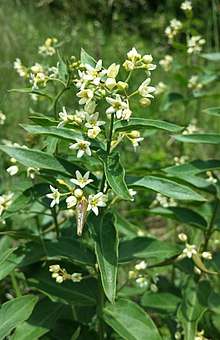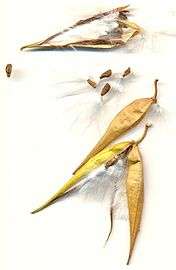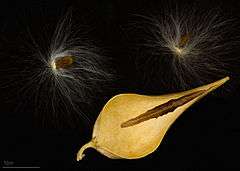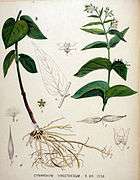Vincetoxicum hirundinaria
Vincetoxicum hirundinaria, commonly named white swallow-wort, is a long-lived herbaceous perennial of the genus Vincetoxicum in the family Apocynaceae.
| Vincetoxicum hirundinaria | |
|---|---|
 | |
| Scientific classification | |
| Kingdom: | Plantae |
| Clade: | Tracheophytes |
| Clade: | Angiosperms |
| Clade: | Eudicots |
| Clade: | Asterids |
| Order: | Gentianales |
| Family: | Apocynaceae |
| Genus: | Vincetoxicum |
| Species: | V. hirundinaria |
| Binomial name | |
| Vincetoxicum hirundinaria | |
| Synonyms[1] | |
|
Asclepias vincetoxicum L. | |
Etymology
The generic name Vincetoxicum, in Latin meaning ‘conqueror of poison’, derives from the traditional use of this plant has as an antidote to poisons.[2] The Latin species name hirundinaria (from hirundo, meaning swallow) and the common name white swallow-wort refer to its seedpods, that are reminiscent of a swallow's wing, or tail.
Description
Vincetoxicum hirundinaria can reach a height of 30–70 centimetres (12–28 in). Stem is erect, stout and glabrous. Flowers in whorls form a raceme. They have a diamenter of about 1 centimetre (0.39 in). Corolla has five white petals. Calyx is composed by five fused, sharp-pointed sepals. Leaves are opposite, ovate to lanceolate and short-stalked. Fruits reach a length of about 5 cm and contain many seeds showing a tuft of white hairs. Flowering time lasts from June to the end of July.[2]
Distribution and habitat
This species is native to cliffs and slopes, especially in calcareous soils, of continental Eurasia (including some Baltic islands).[3] There are introduced populations in North America (Ontario, Michigan, and New York).[1] It is not present in Great Britain and Ireland.
Human culture
Vincetoxicum hirundinaria is a venomous plant traditionally used in treating diseases and in magic. The plant was mentioned by Pedanius Dioscorides as a traditional plant used by Dacians and known as the "herb of animals", believed to open any locked door.[4]
Gallery
- Close-up on flowers
 Seeds and hairy wool
Seeds and hairy wool Fruit and seeds
Fruit and seeds Illustration
Illustration
References
- "Cynanchum vincetoxicum (L.) Pers".
- Nature Gate
- Leimu, R (Jan 2004). "Variation in the mating system of Vincetoxicum hirundinaria (Asclepiadaceae) in peripheral island populations" (Free full text). Annals of Botany. 93 (1): 107–13. doi:10.1093/aob/mch012. ISSN 0305-7364. PMC 4242266. PMID 14678943.
- Bucurescu, Adrian (22 August 2012). "Iarba fiarelor". The Epoch Times, Romania. Retrieved 24 March 2013.
External links

